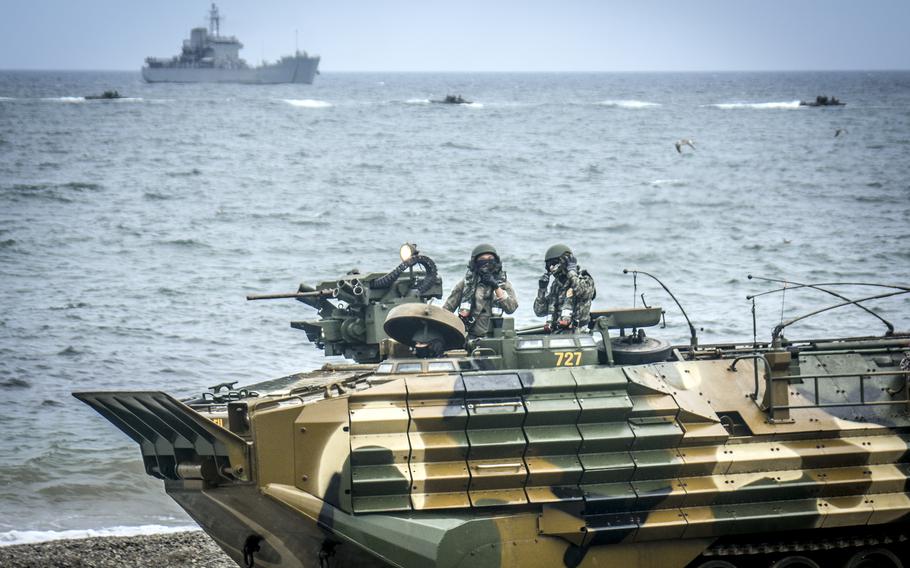
South Korean marines keep an eye on the beach during amphibious-assault training in Pohang, South Korea, Sept. 2, 2024. (Luis Garcia/Stars and Stripes)
POHANG, South Korea — Explosions rocked the beach and fifth-generation fighters roared overhead as U.S. and South Korean marines and sailors rehearsed an amphibious landing this week on South Korea’s southeastern coast.
Roughly 9,500 Marines and sailors and 3,500 of their South Korean counterparts are taking part in this year’s Ssangyong exercise in Pohang, a coastal city roughly 150 miles below Seoul. Ssangyong, which kicked off Aug. 26, translates to “twin dragons” and refers to the cooperating militaries. The exercise concludes on Saturday.
Foot-high waves and a stiff wind met the incoming marines, along with brief showers that soaked the beach and hindered their movements.
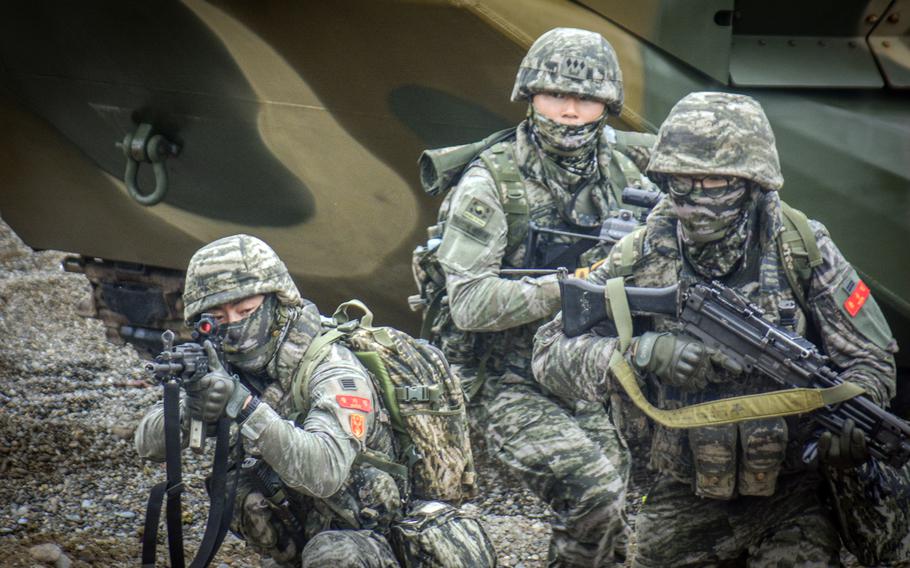
South Korean marines take their positions during a mock amphibious assault on a beach in Pohang, South Korea, Sept. 2, 2024. (Luis Garcia/Stars and Stripes)
The annual drill this year brought two Marine Expeditionary Units to South Korea, rather than one, along with the first use on the Korean Peninsula of the Corps’ recently introduced amphibious combat vehicle.
A host of U.S. and South Korean military hardware was on display during Monday’s simulated amphibious assault, which the allies describe as a defensive measure meant to enhance their joint operations on land, air and sea.
Shockwaves from explosives planted on the beachhead sent sand, seawater and seaweed flying into the air to simulate the initial bombardment by aircraft and warships prior to the amphibious operation that afternoon.
U.S. and South Korean F-35B Lightning IIs flew over the beach, followed by a fleet of MV-22 Ospreys, and UH-1Y Venom and AH-1Z Viper helicopters.
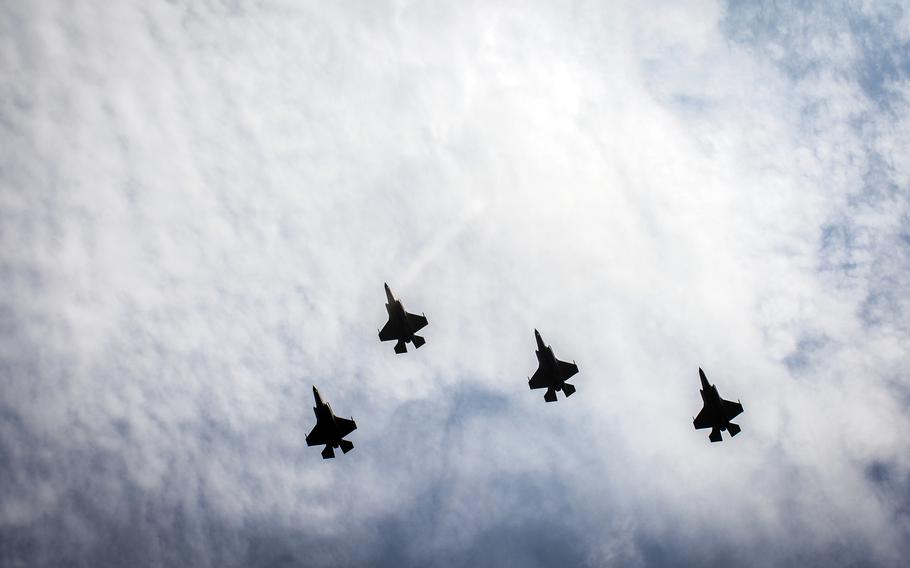
South Korean F-35B Lightning II stealth fighters roar over Pohang, South Korea, during a mock amphibious assault, Sept. 2, 2024. (Luis Garcia/Stars and Stripes)
South Korean C-130Hs followed behind, airdropping dozens of marines into a landing zone roughly a mile from the site.
Less than an hour after the initial explosions, South Korean warships moored nearby unloaded more than a dozen South Korea amphibious assault vehicles. The stream of vehicles drove 15-20 minutes in single file before reaching the beachhead. South Korean marines hustled from the tracked vehicles and took cover in the sand dunes, their weapons drawn.
The U.S. Marines arrived in their combat vehicles at a separate, nearby beachhead due to safety concerns after deteriorating weather conditions prompted last-minute changes to their plans, 3rd Marine Expeditionary Brigade spokesman Maj. George McArthur told Stars and Stripes on Monday.
The Marines this year combined two expeditionary units for the exercise: the 15th MEU out of Camp Pendleton, Calif., and the 31st MEU out of Okinawa, McArthur said.
“Rehearing these kinds of combined joint forcible entry operations with an amphibious landing, then following operations ashore is very important because of how complex they are,” 31st MEU commander Lt. Col. Gabriel Tiggs told reporters Monday. “The defense of the Korean Peninsula depends on our [South Korean] and U.S. forces continuously working together, shoulder to shoulder, including this and future Ssangyong exercises.”
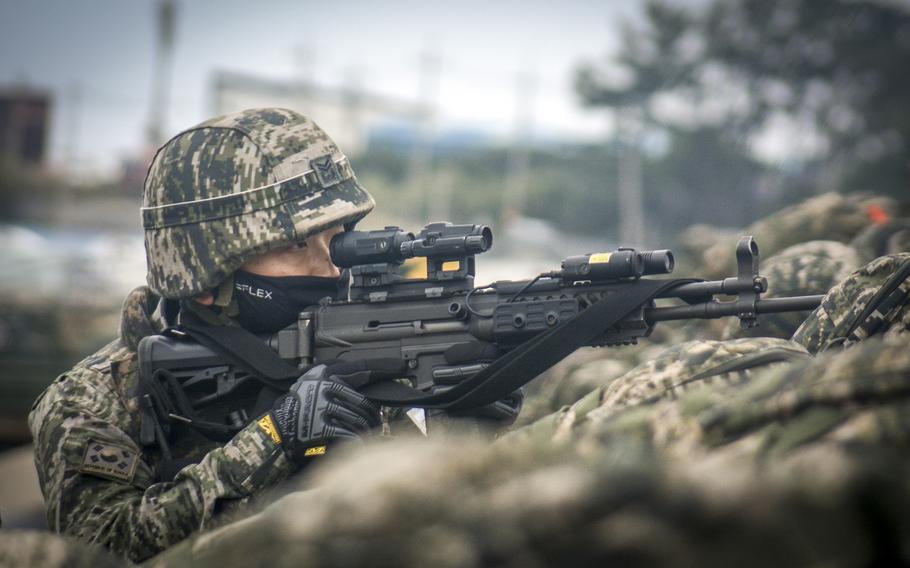
A South Korean marine takes his position during a mock amphibious assault on a beach in Pohang, South Korea, Sept. 2, 2024. (Luis Garcia/Stars and Stripes)
The amphibious training comes on the heels of Ulchi Freedom Shield, an 11-day, large-scale joint exercise throughout South Korea. The semiannual training that ended Thursday addressed specific threats by North Korea, such as GPS jamming, cyberattacks, aerial interceptions and ground combat, according to the South’s Ministry of National Defense.
McArthur said Ssangyong was not tailored to a specific country, adding that the U.S. and South Korean militaries “always aim to increase a progressive set of capabilities and processes to work together.”
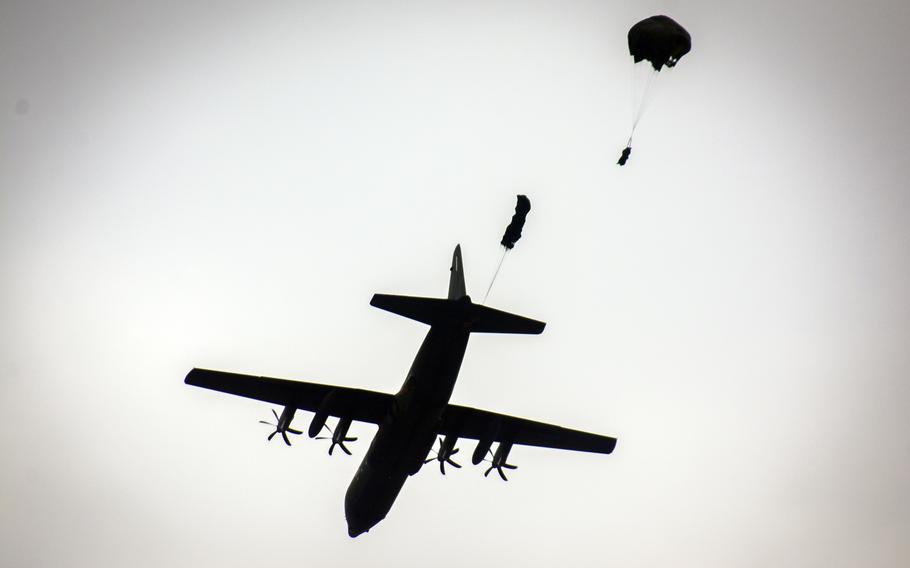
An AC-130 gunship drops South Korean paratroopers during a mock amphibious assault on a beach in Pohang, South Korea, Sept. 2, 2024. (Luis Garcia/Stars and Stripes)